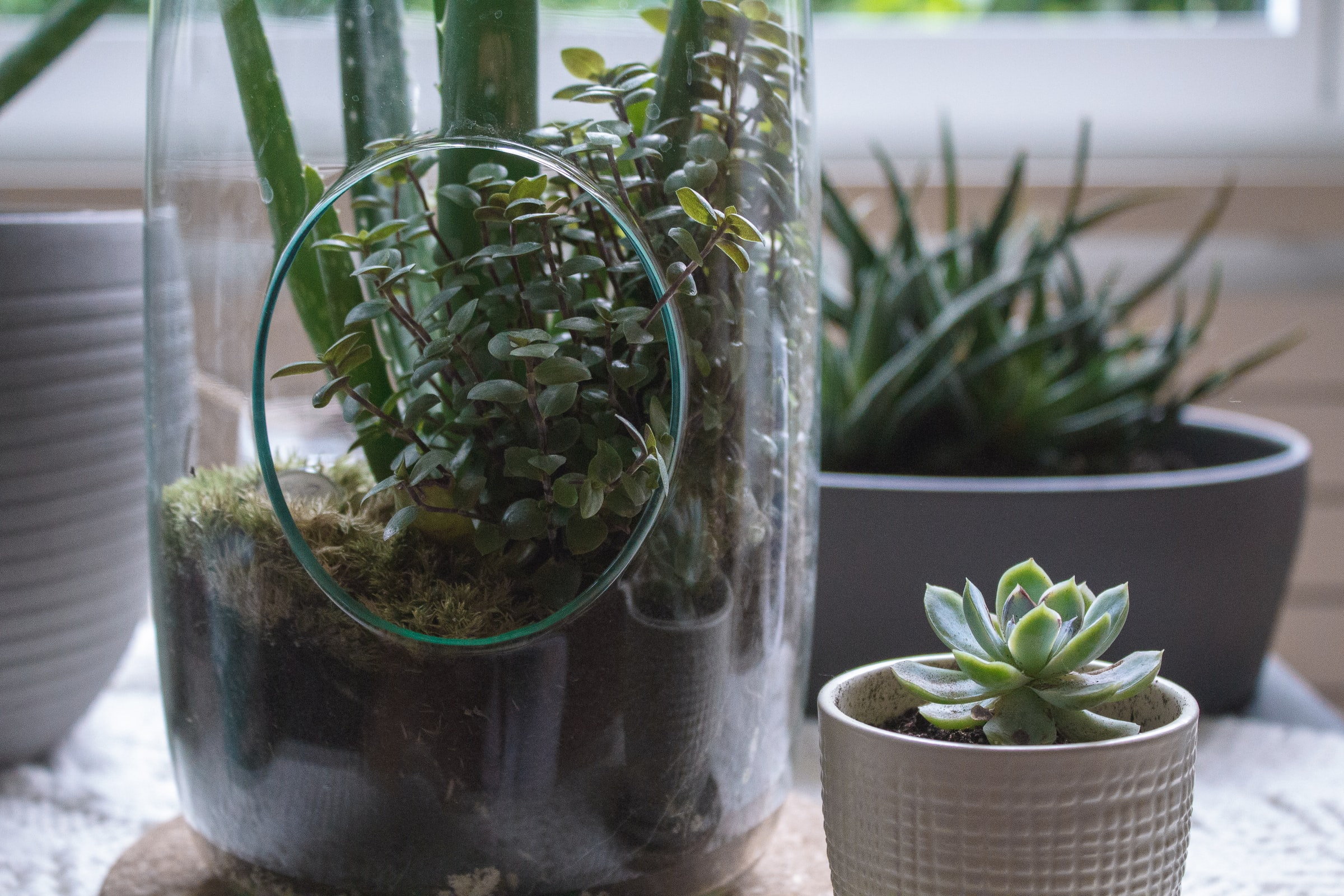What is a Terrarium?
As a general rule of thumb, terrariums are self-sustaining ecosystems. At its most basic form, a terrarium is defined as a sealed transparent globe or similar vessel in which plants are grown.
Having a seal is what allows these vessels to become self-sustaining ecosystems. Once a glass jar is sealed, it becomes its own little rainforest. A terrarium is typically going to range from 70-90% humidity due to the lid. Because of this, we focus entirely on Tropical Plants. When you see cacti or succulents in a terrarium, this is a completely different ballgame. Those terrariums are “open terrariums” and what we focus on is “closed terrariums”
The properties of a terrarium are very similar to what you see in the real world. Just like in a forest after it rains, the plants, soil and mosses are going to absorb all the water they desire. Once they’re done with that water, they will “push” the water back out. In the real world, it’ll evaporate into the sky and capture in the clouds, eventually raining back down on us.
In a terrarium, the same exact process is happening! The lid serves as your cloud and instead of evaporating, all of that moisture condenses on the side of the glass. That condensation will become so heavy over time that it will either drip back down onto the soil or slide down the glass, essentially raining on itself! This is what allows terrariums to be self-sustaining.
Now the big difference is in the type of lid you have. Some types of lids like corks, screw on lids, or sealed jars can be watered once a year to potentially once every few years. If you want to see something cool, google “World Record Terrarium” to see a terrarium that hasn’t been watered in over 60 years!
If your lid is a loose fitting lid and doesn’t completely seal, you’ll be watering more often. This depends entirely on how loose your lid is. The tighter the lid the less often you water.
How do you know when it’s time to water?
Watering your terrarium is an art and can take some getting used to. What you want to pay attention to is the color of the soil and the amount of condensation. We always want to see a small amount of condensation along the glass and in the lid. This is what keeps the terrarium watered. For the soil, we like a nice dark brown, saturated soil.
Once the soil has turned completely light brown and there is no condensation, it’s time to water.
When you’re going to water your terrarium, we like to recommend using a spray bottle and spraying a stream along the edges of the glass, rotating in a circular motion.
You’ll know you’ve added enough water once about 90% of the soil has turned dark brown!
What type of light does my terrarium want?
Because we focus on closed terrariums and all of our plants are tropical, we want to replicate their natural environment as best as possible.
To do this, we recommend focusing on North or East facing windows. This allows your terrarium to be in bright but indirect light. We never want to expose our terrarium to too much direct light as the plants will overheat and the moss will brown very quickly.
If you don’t have a good North or East facing window, South and West can still work as long as you provide INDIRECT light rather than DIRECT light. This is essential to keeping your terrarium happy!
How do the plants breathe?
This is one of the coolest parts about terrariums! There is a beautiful, symbiotic relationship going on at all times inside of the terrarium.
Inside of the soil is millions and millions of little microorganisms called microbes. Those little fellas are constantly eating away at any leaves that fall into the soil or any decaying material. Think of this like composting your soil. Through that process, they release a tiny amount of Carbon Dioxide. This is what your plants will breathe in! Just like in the real world, plants breathe in Carbon Dioxide and will exhale Oxygen. The Oxygen is what those little microbes are breathing in to compost the soil.
So you have the plants producing what the soil needs and the soil producing what the plants need. Because of this relationship, this can last forever!
Wrapping it all up!
If you can take away anything from this blog, please remember North and East facing windows are ideal as we want Bright but Indirect Light. I know watering can be different for each terrarium, but remember that the tighter the seal, the less often you water. And the key indicators are how saturated the soil look and how much condensation is there in the terrarium.

